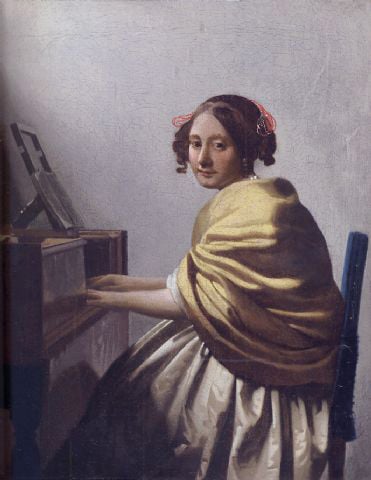
An authentic Vermeer painting is a rare sight to see at auction. Since the re-discovery of the 17th century Dutch master by journalist and art critic Théophile Thoré-Bürger in the 1860s, paintings by Johannes Vermeer (Dutch, 1632–1675) were only seen in the market a few times, and were last offered at auction in 1921. Today, his small body of work is almost exclusively owned by public institutions.
A Young Woman Seated at the Virginal (c.1670) is the only known Vermeer painting housed in a private collection. In 1960, Baron Frédéric Rolin acquired the painting through Marlborough Fine Art Ltd. in London, England. At the time of the Baron’s acquisition, most Vermeer experts and scholars doubted, not only its authorship, but its authenticity, and considered it to be either a 20th century fake or an early 19th century pastiche.1 In spite of the overwhelming opinion to the contrary, Baron Rolin believed his painting to be a true Vermeer. To prove his theory, Rolin commissioned a technical examination of the work in 1995, which gave the disbelieving scholars a chance to examine the painting up close and re-evaluate its attribution.
Johannes Vermeer, A Young Woman Seated at the Virginal, c.1670, sold for US$30,140,259 at Sotheby’s London
In 2001, the Rolin painting was included last minute in the Vermeer and the Delft School exhibition at the Metropolitan Museum of Art in New York and at the National Gallery in London. Though the evidence was not yet conclusive, this viewing gave the painting a chance to be seen by a much wider audience of scholars and critics. Its resemblance to the similarly titled A Lady Seated at a Virginal (c.1670–1675) did not go unnoticed, though Rolin’s painting measured only 9.9 x 7.9 in., half the size of the comparable work. Within the small frame, a young woman sits against a non-descript gray wall, wearing a cream-colored skirt and yellow shawl with arms outstretched. She is seen from the side, though her face looks directly at the viewer. The space is illuminated by an unseen source of natural light in the upper left-hand corner of the image. Though the palette and composition are suggestive of a Vermeer work, many believe that the painting lacks the very particular details that so characterize the Dutch master’s style.
Through technical research, traces of tin were found in the yellow pigment. Lead-tin yellow was commonly used by artists from the Middle Ages through the 17th century, but was rarely—if ever—used after 1700. A different dating method was used to research the style of clothing and hair worn by the figure in the painting. It was determined that the hairstyle depicted was only fashionable for a few years around 1670, placing the painting in the last years of Vermeer’s career. Ultramarine blue was also found in the gray mixture of the background. It is well known that Vermeer preferred this expensive blue pigment over cheaper options available in his time, and the inconspicuous use of ultramarine in the background is something one would typically see in a Vermeer painting.2 Because there are no surviving documents written by Vermeer, and no proof that he ever had any pupils to pass on his artistic methods, little is known of how the artist worked. However, his paintings are very distinct and tell us a lot about his modus operandi. It has often been thought that Vermeer used a camera obscura in order to create an accurate representation of three-dimensionality. Physical evidence has shown that he most likely used the pin-hole method as well. An X-ray of the painting in question made it possible to see this same pin hole that exists in many other Vermeer paintings.
According to the researchers, more than enough evidence was uncovered to prove that this painting is indeed a true work by Vermeer. However, questions still remain as to whether or not the retouching was done by the same hand. There are visible pentimenti—alterations to the painting—and X-ray and infra-red technology provide a look at a different composition underneath, with the figure wearing a jacket instead of a shawl. These alterations were made not too long after the first composition was completed. Arthur Wheelock, a Vermeer expert, believes this work was sold along with Girl with a Flute (c.1665–1670) shortly after the artist’s death, and then touched up to make the work appear more expensive.3
After nearly 10 years of research, Sotheby’s announced the sale of the newly attributed painting by Johannes Vermeer, A Young Woman Seated at the Virginal. On July 7, 2004, the painting sold for GBP£16,245,600, which amounts to approximately US$30,140,259. The painting is still in the possession of a private collector, but has been loaned to institutions for public viewing. Its most recent appearance was at the Scuderie del Quirinale in Rome in early 2013.
1 Libby Sheldon and Nicola Costaras, “Johannes Vermeer’s Young Woman Seated at a Virginal,” Burlington Magazine,148, no. 1235 (February 2006): 89–97. http://burlington.org.uk/magazine/back-issues/2006/200602/.
2 Ibid.
3 Jonathan Janson, “Essential Vermeer,” Essential Vermeer,accessed July 9, 2013, http://www.essentialvermeer.com.